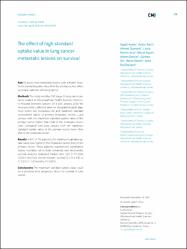The effect of high standard uptake value in lung cancer metastatic lesions on survival

Göster/
Erişim
info:eu-repo/semantics/openAccessTarih
2023Yazar
Aydın, SuphiBalcı, Aydın
Dumanlı, Ahmet
Acar, Leyla Nesrin
Ayşin, Murat
Gencer, Adem
Öz, Gürhan
Demir, Hacer
Davarcı, Sena Ece
Üst veri
Tüm öğe kaydını gösterKünye
Aydin, S., Balcı, A., Dumanlı, A., Acar, L. N., Ayşin, M., Gencer, A., ... & Davarcı, S. E. (2023). The effect of high standard uptake value in lung cancer metastatic lesions on survival. Croatian Medical Journal, 64(3), 179.Özet
Aim: To assess how metastatic lesions with a higher maximum standard uptake value than the primary tumor affect survival in patients with lung cancer.
Methods: The study enrolled 590 stage-IV lung cancer patients treated at Afyonkarahisar Health Sciences University Hospital between January 2013 and January 2020. We retrospectively collected data on histopathological diagnosis, tumor size, metastasis site, and maximum standard involvement values of primary metastatic lesions. Lung cancers with the maximum standard uptake value of the primary tumor higher than that of the metastatic lesion were compared with lung cancers with the maximum standard uptake value of the primary tumor lower than that of the metastatic lesion.
Results: In 87 (14.7%) patients, the maximum standard uptake value was higher in the metastatic lesion than in the primary lesion. These patients experienced significantly higher mortality risk in both univariate and multivariate survival analyses (adjusted hazard ratio 2.25 [1.77-2.86], <0.001) and had shorter median survival (5.0 [4.2-5.8] vs 11.0 [10.2-11.8] months, P<0.001).
Conclusions: The maximum standard uptake value could be a potential new prognostic factor for survival in lung cancer.















